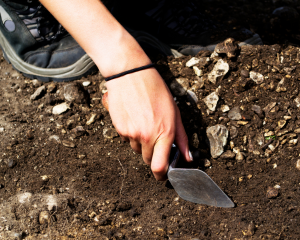Celtic treasures, unearthed as a “lost ancient capital city” is discovered in France

Celtic treasure, including jewellery, weapons and priceless artefacts unearthed as a “lost ancient capital city” is discovered near Gannat, in central France
Hundreds of ancient objects have been found by archaeologists from the University of Toulouse – Jean Jaures, in a dig site near Gannat in central France. Farming tools, swords, extravagant jewellery and chariot pieces were all part of the discovery.
The archaeologists who discovered this Bronze Age hillfort think that, due to the abundance of treasure and sheer size of the site, it may represent a lost Celtic capital city and that the items were buried as part of a ritualistic offering.
Excavations revealed a large, 30 hectares in total, fortified settlement, which experts believe would have sported stone walls up to 20-feet-high. The recovery of such a find was not only very exciting, but also timely, as one of the deposits had already been partially looted.
The archaeological site has yielded hundreds of different items, thought to have been buried in around 800 BC. This type of a find is rare from French hillforts. It actually represents one of the richest metal deposit sites from the Bronze Age ever discovered in Europe, experts have said.
During the time of the Gannat Hill Fort, the Allier region had significant economic value due to the navigable Sioule river and local tin deposits for making bronze. The treasure found at the Gannat site was spread across five different deposits, with one of these already being a target of scavengers, as explained team leader and archaeologist Pierre-Yves Milcent of the University of Toulouse–Jean Jaurès.
“We intervened on this site because there was looting by people equipped with metal detectors who then resell their loot on the internet, where there is a whole parallel market, “he explained.
“The excavations are not complete, but we already have around 800 objects, the majority intact.”
“This is also the first time that we have found four intact hoards that we can excavate in the laboratory under the best conditions.”
The archaeologists believe that the deposit, of which three were arranged in vases, may have been buried to form a divine offering. Bringing to light the suspicion that this may have been a religious ritual site.

“The decorations and symbols of the bronze objects refer to a cult of the sun, which was a very important deity at the time, as in Egypt,” said Dr Milcent.
Based on their dimensions, the researchers believe that the jewellery items, which also included anklets, were most likely worn by women and children. A unique element to the deposits, came in the form of river pebbles, which appear to have been added due to their colour, white in one hoard, while red in another.
What also makes this find significant is the fact that the artefacts are helping the researchers to paint a picture of what life might have been like in this Celtic society, some 2,800 years ago.
Among the objects unearthed are items linked to farming, tools for manufacturing textiles and ceramics, and equipment for wood and metalworking. There are signs of wealth also, including parts from chariots, harnesses that would have been worn by horses, and extravagant jewellery.
The Celts were a distinct group of Indo-European people who gave rise to the Britons, Gaels and Gauls among others. They migrated to what is modern-day France from Central Europe. Today, France’s northwesternmost region, Brittany, remains one of the six officially recognised Celtic nations: Ireland, Scotland, Wales, Brittany, Cornwall and the Isle of Man.
Interested in learning more about Archaeology? Here at Learn for Pleasure, we have a number of archaeological courses:
- Introduction to Archaeological Techniques: Excavation and Environment (ARCH025)
- Introduction to Archaeological Techniques: Science and Theory (ARCH026)
- Understanding Human Environments in British Prehistory (ARCH009)
- Ritual Landscapes in Neolithic Britain (ARCH016)
- Britain in the Bronze Age: Earlier Period – Monuments, Ritual and Round Barrows, 2500BC-1600BC (ARCH032)
- Britain in the Bronze Age: Later Period – Farmsteads, Hoards and Hierarchy, 1600BC-800BC (ARCH033)
And many more courses are available by visiting our website: https://learnforpleasure.com/
Follow us on:
Facebook – https://www.facebook.com/learnforpleasure/
Twitter – https://twitter.com/learn4pleasure
Instagram – https://www.instagram.com/learnforpleasure/

